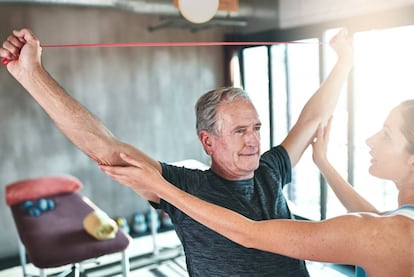Three signs you may already have osteoporosis
Despite the fact that it has few symptoms, there are still ways to check whether you are suffering from the bone disease

It’s one thing to know the risk factors for osteoporosis – family history, smoking, being a small-framed or postmenopausal woman – but would you recognize the warning signs you already have the bone disease?
It’s never too late to do something about your bone health
Osteoporosis develops silently. A person does not feel the gradual loss of bone. For the most part this disease is asymptomatic until there are clear warning signs staring you in the face. These signs usually do not appear until the disease is more advanced.
Here are three signs that you may already have osteoporosis:
1. Fractures that occur from minimal force. It is one thing to fracture or break a bone in a car crash or falling from a ladder. But if you break a bone just by bumping into something or falling a short distance, this could be a sign you have osteoporosis.
2. Unexplained bone or joint pain. At first, osteoporosis causes no symptoms because bone density loss occurs very gradually. Some people never develop symptoms. However, when osteoporosis causes bones to fracture or break, people may experience pain depending on the type of fracture. Many things can cause bone or joint pain but osteoporosis may be at fault. Injuries occur when your bones do not have enough strength to support the weight of your body. Any time you have bone or joint pain that cannot be easily explained, it may be linked to a problem with your bone health.
3. Loss of height or stooping. Osteoporosis can result in loss of height because the discs between the vertebrae in the spine dehydrate and compress. As the spine ages, it can also become curved as the vertebrae collapse (compression fracture) due to loss of bone density (osteoporosis). Loss of muscle tone in the torso can also contribute to a stooped posture. Sometimes a person can have a compression fracture of the spine that may go undetected or be attributed to a back strain type of injury.
If you are experiencing any of the above warning signs, see your doctor to request a bone-density test. Osteoporosis can only be diagnosed by knowing your bone density. The treatment for this condition is best determined once you know the extent of the disease.
Steps to stop/reduce osteoporosis
The best time to catch and treat osteoporosis is before you develop any signs or symptoms. Knowing and understanding the risk factors for this disease is important. This can help you make lifestyle changes before the condition has set in.
Osteoporosis can only be diagnosed by knowing your bone density
It may seem daunting to try to prevent osteoporosis, especially if you have several of the risk factors. But it’s important to realize there are some risk factors that are within your control. It’s never too late to do something about your bone health. Here is how you can reduce your risk of developing osteoporosis.
- Get enough calcium by eating a well-balanced diet. The best sources of calcium include dairy foods such as milk, yogurt and cheese, and some plant-based foods like broccoli, Brussels sprouts, beans and lentils. Orange and grape juice with calcium are also good options.
- Get out in the sun. Sunlight encourages the body to produce vitamin D, which is needed to absorb calcium.
- Eat food rich in vitamin D. The best sources of this fat-soluble vitamin are fatty fish such as salmon, tuna and mackerel, as well as egg yolks, beef liver, cheese and milk.
- Exercise. Weight-bearing exercises such as brisk walking, jogging/running, jumping rope, weight lifting, playing tennis, racquetball, or dancing are perfect ways to build strong bones.
- Do not smoke or drink excessively (more than one drink a day for a woman or two drinks a day for a man). These unhealthy activities can weaken your bones.
Dr. Samadi is a board-certified urologic oncologist trained in open and traditional and laparoscopic surgery and is an expert in robotic prostate surgery. He is chairman of urology, chief of robotic surgery at Lenox Hill Hospital. He is a medical contributor for the Fox News Channel’s Medical A-Team. Follow Dr. Samadi on Twitter, Pinterest, SamadiMD.com, davidsamadiwiki, davidsamadibio and Facebook.
Tu suscripción se está usando en otro dispositivo
¿Quieres añadir otro usuario a tu suscripción?
Si continúas leyendo en este dispositivo, no se podrá leer en el otro.
FlechaTu suscripción se está usando en otro dispositivo y solo puedes acceder a EL PAÍS desde un dispositivo a la vez.
Si quieres compartir tu cuenta, cambia tu suscripción a la modalidad Premium, así podrás añadir otro usuario. Cada uno accederá con su propia cuenta de email, lo que os permitirá personalizar vuestra experiencia en EL PAÍS.
¿Tienes una suscripción de empresa? Accede aquí para contratar más cuentas.
En el caso de no saber quién está usando tu cuenta, te recomendamos cambiar tu contraseña aquí.
Si decides continuar compartiendo tu cuenta, este mensaje se mostrará en tu dispositivo y en el de la otra persona que está usando tu cuenta de forma indefinida, afectando a tu experiencia de lectura. Puedes consultar aquí los términos y condiciones de la suscripción digital.
Más información
Archivado En
Últimas noticias
Lo más visto
- Uno de los promotores de la señal V-16 de tráfico: “Es duro oír el testimonio de víctimas que han sufrido amputaciones al poner los triángulos”
- Más de 40 congresistas demócratas piden por carta a Trump que cese en sus “intentos de socavar la democracia en Brasil”
- Cae una organización que enviaba camiones cargados de cocaína desde Marbella hasta varios países europeos
- La policía registra varios domicilios y las oficinas de la ministra francesa Rachida Dati por otro presunto caso de corrupción
- Jornada política del 20 de diciembre de 2025 | El PP suaviza su discurso sobre “pucherazo” en Extremadura y felicita a la Guardia Civil






























































